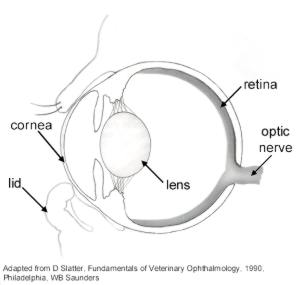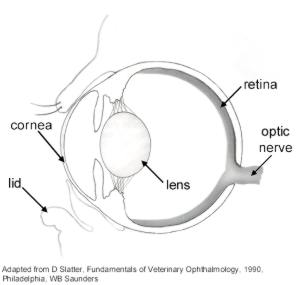Back To Home Page
|
Another topic of great debate, to tack or not to tack, to have entropion surgery or not.
The Chinese Shar-Pei are born with wrinkled faces. Some pups more than others. The eyes are closed at birth and open from about 14-19 days........and then some never open, or open a little and shut tight again........what to do, if this is a show puppy we want natural untouched eyes, and yes many lines have successfully had generations, eye tack and surgery free, but it is not easy to get. I have bred tack and surgery free lines and adults and still not been able to get tack free eyes. For a breeder it is very frustrating, but even more so for the puppy buyer that has these situations crop up. Eyes can shut at any time during your dogs life and there are many reasons for it, including stress, walks where debris or pine needles can get into the dog or pups eyes. Just because a puppy is born with tack free eyes does NOT MEAN it will be free of this for the rest of its life, and just because a puppy does have eye tacks does not mean you will have any further problems with this condition either. What is Entropion? Entropion is the inward rolling of the eyelid, most commonly the lower lid. This irritates the surface of the eye (the cornea) and may ultimately cause visual impairment, by way of scratching this cornea and causing the same affect as taking sandpaper to a smooth surface, thus small scratches. See illustration. 
Entropion is common in giant breeds such as the Great Dane, Bernese Mountain Dog, Mastiff, Saint Bernard, Newfoundland, and Great Pyrenees. In these breeds the central lower lid is often ectropic while the lid at the corners of the eye is entropic, which means you have both conditions occurring. The corner is rolling in and the center is hanging too low.
For many breeds and many disorders, the studies to determine the mode of inheritance or the frequency in the breed have not been carried out, or are inconclusive. We have listed breeds for which there is a consensus among those investigating in this field and among veterinary practitioners, that the condition is significant in this breed.
What does entropion mean to your dog & you? The problem is usually evident before a year of age. Discomfort from entropion will cause increased tearing and squinting. Your dog may be sensitive to light and may rub at its eyes. Chronic irritation by the turned-in eyelid may cause corneal ulceration and scarring which is painful and, if not corrected, can impair vision.
Dogs who have had surgical correction for a defect such as entropion may not be exhibited in the show ring.
How is entropion diagnosed? The inrolling of the eyelid is readily apparent. Generally both eyes are affected. Depending on the degree of corneal irritation and the duration, there will be other signs such as those mentioned above. Your veterinarian will evaluate the degree of entropion and use flourescein dye to determine if there is any corneal ulceration.
FOR THE VETERINARIAN: The use of topical ophthalmic anaesthetic to anaesthetize the cornea and conjunctiva will enable eliminatation of the spastic component of the entropion in order to better evaluate the anatomic component. This is important before surgery is performed.
How is entropion treated? Entropion is corrected surgically. If possible it is best to delay surgery until the dog is an adult since the involved facial structures are still growing and changing. More than 1 operation may be required. It is better to correct the entropion conservatively andrepeat the operation later if necessary, than to overcorrect causing ectropion. In breeds such as the chow chow that have particularly severe entropion related to heavy facial folds, several surgeries may be required.
Breeding advice- Entropion is one of the eye conditions that is a result of selection by breeders and a demand by the public for such features as excessively prominent eyes and heavy facial folds. A responsible breeding programme will choose animals for breeding with a more normal head conformation, so as to select away from these exaggerated facial features and the problems
associated with them. The Vizsla Club of America has recognized entropion as an unacceptable problem in their breed, and advises breeders not to breed affected animals. Such leadership by breed clubs is important in discouraging this and other undesirable traits.
Temporary Entropion- Entropion is an eye problem that causes the puppy's eyelids to roll inward. As a result, the eyelashes rubbing against the cornea cause acute distress. Symptoms of eye problems include pawing at the eyes and excessive tearing, leading to a cloudy discharge. I have found it very useful to use lubricating eye drops in the puppies eyes once a day, or polysporin or even castor oil. Especially when still teething, blowing coat, when in season or around females in season, or during stressful stays at kennels etc. There is a chance that your Shar-Pei's eyes may blink or water slightly, something which can also happen if your Shar-Pei is stressed. This will usually subside when the temporary problem has been solved. The face, and around the back of the ears, can be bathed with a mild solution of salt water and polysporin drops may be used if necessary. Always take care not to transfer infection from one eye to the other and be sure to use a different piece of cotton wool to bathe each eye. Usually 48 hours will allow the eye to return to normal, otherwise vet attention may be required to prevent an ulcer from forming, which is caused from continual rubbing of the eyelashes on the eye, and this will be visible to the human eye as it appears as a white area.
Even when you have all the posts in place for great eyes, you are still facing other health problems that may be more concerning than eyes. My rule of thumb was and still is, if a pup requires eye tacking, it is done, and if it does not then it is not done, but the bottom line here is health should never be sacrificed for good eyes, a good breeding program requires all concerns to be monitored and if I had to choose tacking eyes over fevers, amyloidosis, cancers and allergies, then that would be my decision, as is all breeding decisions amongst breeders. Any decisions on puppy or dog owners to pursue entropion surgery should always be discussed with an experienced breeder, all surgeries and consultation should be discussed with an experienced veterinarian, that is familiar with this breed and this disorder.
FOR MORE INFORMATION ABOUT THIS DISORDER, PLEASE SEE YOUR VETERINARIAN. Where to find more information? What is ectropion? - Ectropion is a defect of conformation in which there is a sagging or rolling-out (eversion) of the eyelids. This results in abnormal exposure of the eye, which often leads to irritation. 
How is ectropion inherited?- It is likely that ectropion is influenced by
several genes (polygenic inheritance) that affect the skin and other structures that make up the eyelids, and that affect the way the skin covers the face and head.
What breeds are affected by ectropion? -Ectropion is most commonly seen in dogs with exaggerated facial features where it is often a breed characteristic. It is found in the Basset Hound, Bloodhound, Boxer, Bulldog, Clumber Spaniel, English and American Cocker Spaniel, Gordon Setter, Labrador Retriever, Springer Spaniel, and Shih Tzu. Ectropion is also common in giant breeds such as the Great Dane, Mastiff, Saint Bernard, Newfoundland, and Great Pyrenees In these breeds the central lower lid is often ectropic while the lid at the corners of the eye is entropic.
For many breeds and many disorders, the studies to determine the mode of inheritance or the frequency in the breed have not been carried out, or are inconclusive. We have listed breeds for which there is a consensus among those investigating in this field and among veterinary practitioners, that the condition is significant in this breed.
What does ectropion mean to your dog & you? - Because of increased exposure of the eye, dogs with ectropion are prone to develop allergic or bacterial the surface of the eye and lines the eyelids. Affected dogs may develop keratoconjunctivitis sicca because of reduced efficiency at wetting and cleaning the cornea.
Dogs who have had surgical correction for a defect such as ectropion are prohibited from exhibition in the show ring.
How is ectropion diagnosed? - In addition to the sagging of the eyelids, dogs with ectropion commonly have a mucopurulent discharge in the eye, reddening of the exposed conjunctiva, and decreased tear production. To check the latter, your veterinarian will do a Schirmer tear test.
How is ectropion treated? With mild ectropion, no treatment may be necessary. If secondary problems such as conjunctivitis develop, these are treated as required. More severe ectropion can lead to chronic problems associated with eye irritation. In these cases, surgery is performed to remove a small wedge of tissue from the margin of the eyelid.
Breeding advice - Ectropion is one of the eye conditions that is a result of selection by breeders and a demand by the public for such features as excessively prominent eyes and heavy facial folds. A responsible breeding programme will choose animals for breeding with a more normal head conformation, so as to select away from these exaggerated facial features and the problems
associated with them. FOR MORE INFORMATION ABOUT THIS DISORDER, PLEASE SEE YOUR VETERINARIAN. Portions of this information were used from ~ Copyright 1998 Canine Inherited Disorders Database. All rights reserved. Revised: April 11, 2000. If you have any questions please feel free to email me. Copyright of Shar-Pei Canadiana (C)2009. - Vicky
Back To Home Page
|